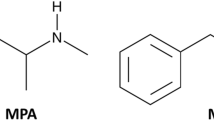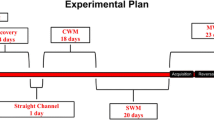Abstract
Rationale
Despite their chemical similarities, methamphetamine and 3,4-methylenedioxymethamphetamine (MDMA) produce differing neurochemical and behavioral responses in animals. In humans, individual studies of methamphetamine and MDMA indicate that the drugs engender overlapping and divergent effects; there are only limited data comparing the two drugs in the same individuals.
Objectives
This study examined the effects of methamphetamine and MDMA using a within-subject design.
Methods
Eleven adult volunteers completed this 13-day residential laboratory study, which consisted of four 3-day blocks of sessions. On the first day of each block, participants received oral methamphetamine (20, 40 mg), MDMA (100 mg), or placebo. Drug plasma concentrations, cardiovascular, subjective, and cognitive/psychomotor performance effects were assessed before drug administration and after. Food intake and sleep were also assessed. On subsequent days of each block, placebo was administered and residual effects were assessed.
Results
Acutely, both drugs increased cardiovascular measures and “positive” subjective effects and decreased food intake. In addition, when asked to identify each drug, participants had difficulty distinguishing between the amphetamines. The drugs also produced divergent effects: methamphetamine improved performance and disrupted sleep, while MDMA increased “negative” subjective-effect ratings. Few residual drug effects were noted for either drug.
Conclusions
It is possible that the differences observed could explain the differential public perception and abuse potential associated with these amphetamines. Alternatively, the route of administration by which the drugs are used recreationally might account for the many of the effects attributed to these drugs (i.e., MDMA is primarily used orally, whereas methamphetamine is used by routes associated with higher abuse potential).






Similar content being viewed by others
References
Allott K, Redman J (2006) Patterns of use and harm reduction practices of ecstasy users in Australia. Drug Alcohol Depend 82:168–176
Baicy K, London ED (2007) Corticolimbic dysregulation and chronic methamphetamine abuse. Addiction 102(Suppl 1):5–15
Bedi G, Hyman D, de Wit H (2010) Is ecstasy an “empathogen”? Effects of 3,4-methylenedioxymethamphetamine on prosocial feelings and identification of emotional states in others. Biol Psychiatry 68:1134–1140
Bolla KI, McCann UD, Ricaurte GA (1998) Memory impairment in abstinent MDMA (“ecstasy”) users. Neurology 51:1532–1537
Cami J, Farre M, Mas M, Roset PN, Poudevida S, Mas A, San L, de la Torre R (2000) Human pharmacology of 3,4-methylenedioxymethamphetamine ("ecstasy"): psychomotor performance and subjective effects. J Clin Psychopharmacol 20:455–466
Cho AK, Melega WP, Kuczenski R, Segal DS (2001) Relevance of pharmacokinetic parameters in animal models of methamphetamine abuse. Synapse 39:161–166
Comer SD, Haney M, Foltin RW, Fischman MW (1996) Amphetamine self-administration by humans: modulation by contingencies associated with task performance. Psychopharmacology 127:39–46
Comer SD, Hart CL, Ward AS, Haney M, Foltin RW, Fischman MW (2001) Effects of repeated oral methamphetamine administration in humans. Psychopharmacology 155:397–404
Cook CE, Jeffcoat AR, Sadler BM, Hill JM, Voyksner RD, Pugh DE, White WR, Perez-Reyes M (1992) Pharmacokinetics of oral methamphetamine and effects of repeated daily dosing in humans. Drug Metab Dispos 20:856–862
Cook CE, Jeffcoat AR, Hill JM, Pugh DE, Patetta PK, Sadler BM, White WR, Perez-Reyes M (1993) Pharmacokinetics of methamphetamine self-administered to human subjects by smoking S-(+)-methamphetamine hydrochloride. Drug Metab Dispos 21:717–723
Crean RD, Davis SA, Von Huben SN, Lay CC, Katner SN, Taffe MA (2006) Effects of (+/−)3,4-methylenedioxymethamphetamine, (+/−)3,4-methylenedioxyamphetamine and methamphetamine on temperature and activity in rhesus macaques. Neuroscience 142:515–525
de Wit H, Dudish S, Ambre J (1993) Subjective and behavioral effects of diazepam depend on its rate of onset. Psychopharmacology 112:324–330
Foltin RW, Fischman MW, Byrne MF (1988) Effects of smoked marijuana on food intake and body weight of humans living in a residential laboratory. Appetite 11:1–14
Foltin RW, Rolls BJ, Moran TH, Kelly TH, McNelis AL, Fischman MW (1992) Caloric, but not macronutrient, compensation by humans for required-eating occasions with meals and snack varying in fat and carbohydrate. Am J Clin Nutr 55:331–342
Grelotti DJ, Kanayama G, Pope HG Jr (2010) Remission of persistent methamphetamine-induced psychosis after electroconvulsive therapy: presentation of a case and review of the literature. Am J Psychiatry 167:17–23
Halkitis PN, Fischgrund BN, Parsons JT (2005) Explanations for methamphetamine use among gay and bisexual men in New York City. Subst Use Misuse 40:1331–1345
Hamamoto DT, Rhodus NL (2009) Methamphetamine abuse and dentistry. Oral Dis 15:27–37
Haney M, Comer SD, Fischman MW, Foltin RW (1997) Alprazolam increases food intake in humans. Psychopharmacology 132:311–314
Haney M, Ward AS, Comer SD, Hart CL, Foltin RW, Fischman MW (2001) Bupropion SR worsens mood during marijuana withdrawal in humans. Psychopharmacology 155:171–179
Haney M, Gunderson EW, Rabkin J, Hart CL, Vosburg SK, Comer SD, Foltin RW (2007) Dronabinol and marijuana in HIV-positive marijuana smokers. Caloric intake, mood and sleep. JAIDS 45:545–554
Hart CL, Ward AS, Haney M, Foltin RW, Fischman MW (2001) Methamphetamine self-administration by humans. Psychopharmacology 157:75–81
Hart CL, Haney M, Foltin RW, Fischman MW (2002) Effects of the NMDA antagonist memantine on human methamphetamine discrimination. Psychopharmacology 164:376–384
Hart CL, Ward AS, Haney M, Nasser J, Foltin RW (2003) Methamphetamine attenuates disruptions in performance and mood during simulated night-shift work. Psychopharmacology 169:42–51
Hart CL, Gunderson EW, Perez A, Kirkpatrick MG, Thurmond A, Comer SD, Foltin RW (2008) Acute physiological and behavioral effects of intranasal methamphetamine in humans. Neuropsychopharmacology 33:1847–1855
Hatsukami DK, Fischman MW (1996) Crack cocaine and cocaine hydrochloride. Are the differences myth or reality? JAMA 276:1580–1588
Holland J (2001) Ecstasy: the complete guide: a comprehensive look at the risks and benefits of MDMA. Park Street Press, Rochester, VT
Hoshi R, Mullins K, Boundy C, Brignell C, Piccini P, Curran HV (2007) Neurocognitive function in current and ex-users of ecstasy in comparison to both matched polydrug-using controls and drug-naïve controls. Psychopharmacology 194:371–379
Johanson CE, Kilbey M, Gatchalian K, Tancer M (2006) Discriminative stimulus effects of 3,4-methylenedioxymethamphetamine (MDMA) in humans trained to discriminate among d-amphetamine, meta-chlorophenylpiperazine and placebo. Drug and Alcohol Dependence 81:27–36
Jones HE, Garrett BE, Griffiths RR (2001) Reinforcing effects of oral cocaine: contextual determinants. Psychopharmacology 154:143–152
Kelly TH, Foltin RW, Emurian CS, Fischman MW (1993) Performance-based testing for drugs of abuse: dose and time profiles of marijuana, amphetamine, alcohol, and diazepam. J Anal Toxicol 17:264–272
Kelly BC, Parsons JT, Wells BE (2006) Prevalence and predictors of club drug use among club-going young adults in New York City. J Urban Health 83:884–895
Kushida CA, Chang A, Gadkary C, Guilleminault C, Carrillo O, Dement WC (2001) Comparison of actigraphic, polysomnographic, and subjective assessment of sleep parameters in sleep-disordered patients. Sleep Med 2:389–396
Kuypers KP, Ramaekers JG (2005) Transient memory impairment after acute dose of 75 mg 3.4-Methylene-dioxymethamphetamine. J Psychopharmacol 19:633–639
Liechti ME, Geyer MA, Hell D, Vollenweider FX (2001) Effects of MDMA (ecstasy) on prepulse inhibition and habituation of startle in humans after pretreatment with citalopram, haloperidol, or ketanserin. Neuropsychopharmacology 24:240–252
Lyvers M (2006) Recreational ecstasy use and the neurotoxic potential of MDMA: current status of the controversy and methodological issues. Drug Alcohol Rev 25:269–276
Marrone GF, Pardo JS, Krauss RM, Hart CL (2010) Amphetamine analogs methamphetamine and 3,4-methylenedioxymethamphetamine (MDMA) differentially affect speech. Psychopharmacology 208:169–177
McLeod DR, Griffiths RR, Bigelow GE, Yingling J (1982) An automated version of the digit symbol substitution test (DSST). Behav Res Meth Instrum 14:463–436
Miller TP, Taylor JL, Tinklenberg JR (1988) A comparison of assessment techniques measuring the effects of methylphenidate, secobarbital, diazepam and diphenhydramine in abstinent alcoholics. Neuropsychobiology 19:90–96
Mohs RC, Tinklenberg JR, Roth WT, Kopell BS (1978) Methamphetamine and diphenhydramine effects on the rate of cognitive processing. Psychopharmacology 59:13–19
Mueller M, Kolbrich EA, Peters FT, Maurer HH, McCann UD, Huestis MA, Ricaurte GA (2009) Direct comparison of (+/−) 3,4-methylenedioxymethamphetamine ("ecstasy") disposition and metabolism in squirrel monkeys and humans. Ther Drug Monit 31:367–373
Parrott AC, Lasky J (1998) Ecstasy (MDMA) effects upon mood and cognition: before, during and after a Saturday night dance. Psychopharmacology 139:261–268
Perez GA, Haney M, Foltin RW, Hart CL (2008a) Modafinil decreases food intake in humans subjected to simulated shift work. Pharmacol Biochem Behav 90:717–722
Perez AY, Kirkpatrick MG, Gunderson EW, Marrone G, Silver R, Foltin RW, Hart CL (2008b) Residual effects of intranasal methamphetamine on sleep, mood, and performance. Drug Alcohol Depend 94:258–262
Peroutka SJ, Newman H, Harris H (1988) Subjective effects of 3,4-methylenedioxymethamphetamine in recreational users. Neuropsychopharmacology 1:273–277
Randall S, Johanson CE, Tancer M, Roehrs T (2009) Effects of acute 3,4-methylenedioxymethamphetamine on sleep and daytime sleepiness in MDMA users: a preliminary study. Sleep 32:1513–1519
Rodgers J, Buchanan T, Pearson C, Parrott AC, Ling J, Hefferman TM, Scholey AB (2006) Differential experiences of the psychobiological sequelae of ecstasy use: quantitative and qualitative data from an internet study. J Psychopharmacol 20:437–446
Rothman RB, Baumann MH, Dersch CM, Romero DV, Rice KC, Carroll FI, Partilla JS (2001) Amphetamine-type central nervous system stimulants release norepinephrine more potently than they release dopamine and serotonin. Synapse 39:32–41
Silber BY, Croft RJ, Papafotiou K, Stough C (2006) The acute effects of d-amphetamine and methamphetamine on attention and psychomotor performance. Psychopharmacology 187:154–169
Silverman K, Kirby KC, Griffiths RR (1994a) Modulation of drug reinforcement by behavioral requirements following drug ingestion. Psychopharmacology 114:243–247
Silverman K, Mumford GK, Griffiths RR (1994b) Enhancing caffeine reinforcement by behavioral requirements following drug ingestion. Psychopharmacology 114:424–432
Simon SL, Richardson K, Dacey J, Glynn S, Domier CP, Rawson RA, Ling W (2002) A comparison of patterns of methamphetamine and cocaine use. J Addict Dis 21:35–44
Stoops WW, Lile JA, Fillmore MT, Glaser PE, Rush CR (2005a) Reinforcing effects of methylphenidate: influence of dose and behavioral demands following drug administration. Psychopharmacology 177:349–355
Stoops WW, Lile JA, Fillmore MT, Glaser PE, Rush CR (2005b) Reinforcing effects of modafinil: influence of dose and behavioral demands following drug administration. Psychopharmacology 182:186–193
Tancer ME, Johanson CE (2001) The subjective effects of MDMA and mCPP in moderate MDMA users. Drug Alcohol Depend 65:97–101
Tancer M, Johanson CE (2003) Reinforcing, subjective, and physiological effects of MDMA in humans: a comparison with d-amphetamine and mCPP. Drug Alcohol Depend 72:33–44
Vollenweider FX, Gamma A, Liechti M, Huber T (1998) Psychological and cardiovascular effects and short-term sequelae of MDMA ("ecstasy") in MDMA-naive healthy volunteers. Neuropsychopharmacology 19:241–251
Wang Z, Woolverton WL (2007) Estimating the relative reinforcing strength of (+/−)-3,4-methylenedioxymethamphetamine (MDMA) and its isomers in rhesus monkeys: comparison to (+)-methamphetamine. Psychopharmacology 189:483–488
Wesnes K, Warburton DM (1983) Effects of smoking on rapid information processing performance. Neuropsychobiology 9:223–229
Acknowledgements
The medical assistance of Drs. Benjamin R Nordstrom and David Mysels and technical assistance of Gydmer Perez and Michaela Bamdad are gratefully acknowledged. This research was supported by grant number DA-03746 from the National Institute on Drug Abuse.
Author information
Authors and Affiliations
Corresponding author
Rights and permissions
About this article
Cite this article
Kirkpatrick, M.G., Gunderson, E.W., Perez, A.Y. et al. A direct comparison of the behavioral and physiological effects of methamphetamine and 3,4-methylenedioxymethamphetamine (MDMA) in humans. Psychopharmacology 219, 109–122 (2012). https://doi.org/10.1007/s00213-011-2383-4
Received:
Accepted:
Published:
Issue Date:
DOI: https://doi.org/10.1007/s00213-011-2383-4




